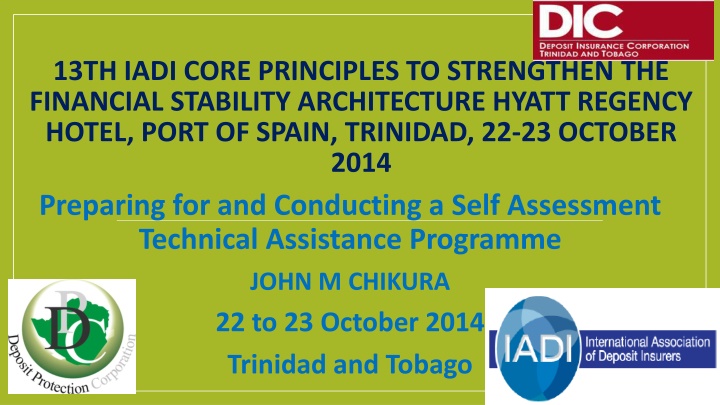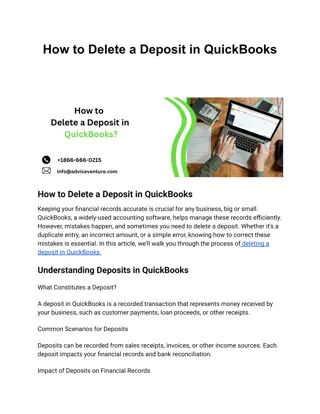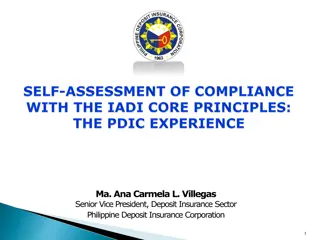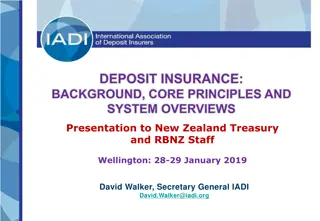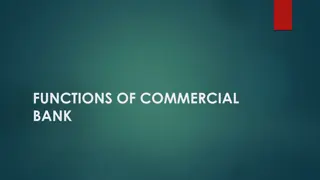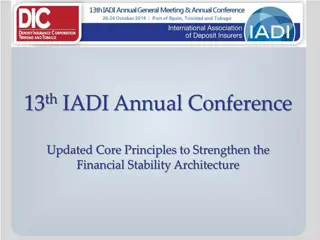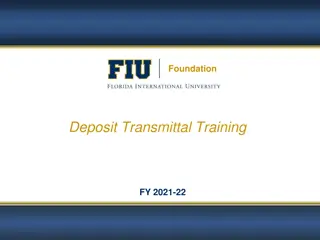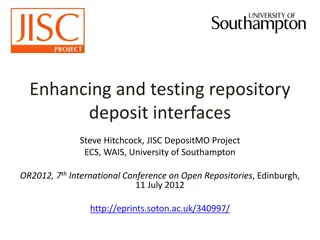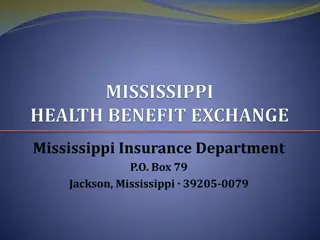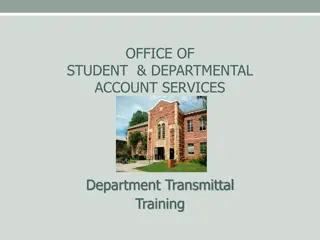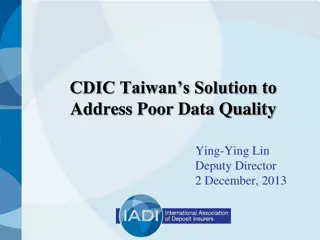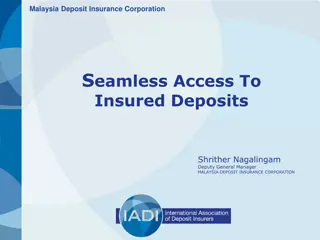Strengthening Financial Stability Architecture through Deposit Insurance Assessment
The presentation discusses the importance of effective deposit insurance systems in the wake of the global financial crisis. It outlines the core principles for evaluating deposit insurance systems, emphasizing the significance of self-assessment and the role of expert reviews. The desired outcomes of self-assessment, preparation guidelines, and the process of conducting assessments are highlighted, providing insights into enhancing financial stability.
Download Presentation

Please find below an Image/Link to download the presentation.
The content on the website is provided AS IS for your information and personal use only. It may not be sold, licensed, or shared on other websites without obtaining consent from the author.If you encounter any issues during the download, it is possible that the publisher has removed the file from their server.
You are allowed to download the files provided on this website for personal or commercial use, subject to the condition that they are used lawfully. All files are the property of their respective owners.
The content on the website is provided AS IS for your information and personal use only. It may not be sold, licensed, or shared on other websites without obtaining consent from the author.
E N D
Presentation Transcript
13TH IADI CORE PRINCIPLES TO STRENGTHEN THE FINANCIAL STABILITY ARCHITECTURE HYATT REGENCY HOTEL, PORT OF SPAIN, TRINIDAD, 22-23 OCTOBER 2014 Preparing for and Conducting a Self Assessment Technical Assistance Programme JOHN M CHIKURA 22 to 23 October 2014 Trinidad and Tobago
Organization of the Presentation Introduction DesiredOutcomes IADIExpertReviewofaSelf-Assessment PreparingforaSelfAssessment ConductingaSelfAssessmentTechnicalAssistanceProgramme Post FieldWork Conclusion 2
Introduction The global financial crisis illustrated the importance of effective depositor compensation arrangements resulting in the Basel Committee on Banking Supervision (BCBS) and the International Association of Deposit Insurers (IADI) jointly issuing in June 2009 the Core Principles (CP) for Effective Deposit Insurance Systems. This established a benchmark, a standard or best practice in deposit insurance. An assessment is a systematic process of gathering, reviewing and using important quantitative and qualitative data and information from multiple and diverse sources for the purpose of evaluating whether core deposit insurance principles and standards are being met. A self assessment (SA) is an assessment conducted by the subject institution i.e the DI itself 3
DesiredOutcomes of Self Assessment SA helps the DI system to effectively and efficiently carry out and meet its set public policy objectives The primary objective is to evaluate compliance with core principles after taking into account the operating environment, structural, legal, & institutional features of each DI system Provide feedback for quality assurance The complex nature of the assessment makes careful planning a critical element of a successful assessment If the assessment is done under IMF/World Bank FSAP the mission will determine the preparation and report production process If conducted as a third party review (consulting firms), a peer review, or a self assessment, a time line may help guide the preparation and completion of the review 4
IADI Expert Review of a Self-Assessment A peer-assessment by an IADI team of experts under the IADI Self- Assessment Technical Assistance Program (SATAP) is an excellent way to prepare for an FSAP review and is markedly less formal process. The review is carried by a team of experts from IADI member jurisdictions and may include a member from the requesting jurisdiction's geographic region and/or members who are familiar with assessing deposit insurance agencies with similar mandates Under SATAP the team reviews relevant documents and spend two to three days on-site to meet with safety-net participants and provide feedback to the deposit insurance agency. A review by an IADI team of experts on compliance with the Core Principles is similar in scope to an FSAP Review, though less intensive. The completion of a self-assessment, as well as evidence that suggested corrective actions are being implemented, may be favorably regarded by FSAP review teams. 5
Elements of A Successful Assessment Purpose identification Data collection Analysis and evaluation A comprehensive review of the operating environment i.e. financial health of the system, structure, strength of regulation & supervision, legal framework, accounting & disclosure regime Assessing the DI against the core principles & identification of gaps Decision-making regarding actions to be taken 6
Preparing for a Self Assessment When conducting a self assessment it is important to be clear on Purpose and Objectives of the assessment Planning for the assessment. Requires a detailed, well thought out work plan with specific timelines as the review of the DI involves many documents The selection of team members must keep in mind the conditions and constraints facing assessors and should include a mix of experienced members in line with the mandate of the deposit insurer. The size of the team depends on how the assessment is undertaken Team roles should be clearly defined designating areas of responsibility If the deposit insurance agency is a risk minimizer, the team should include assessors familiar with risk minimizing If it s a pay box, the assessment team needs staff with an understanding of supervision and insolvency framework. 7
Preparing for a Self Assessment There is need to develop a comprehensive work plan which includes; Conducting preliminary assessment before the field work begins Review of prior assessments, reports, laws and regulations Sending out questionnaires (data gathering), Assessment template of the Core Principles methodology with each Core Principle, The essential Criteria, and Additional Criteria and the Deposit Insurance Agency fills in the details and return the completed questionnaire The questionnaire should be send seven weeks before the actual assessment and the deposit insurance agency given three weeks to respond. The assessors should review the questionnaire and the legal and regulatory framework. Data analysis. To be useful the assessment must be comprehensive enough to enable a judgment on whether criteria are fulfilled in practice, not just in theory or on paper 8
Preparing for a Self Assessment NB: For an assessment to be effective a national counterpart should be appointed early and be in frequent contact with the counterparts. Meetings schedules The team should have extensive discussions with various representatives from the deposit insurance agency The team should also meet players in other safety nets such as; Ministry of Finance, Central Bank, Bankers Association, Private Lawyers Consumer representatives Other safety net players Pre mission assessment Once the questionnaire and supporting documents is received the team should finalize the review of key documents Based on this initial review the team may determine the soundness of the deposit insurance system and identify key gaps 9
Conducting a Self Assessment Technical Assistance Programme The Field work starts by holding meetings with representatives from the deposit insurance agency to discuss each Core Principle; There are four phases to the assessment process; Phase 1 Updating the assessment of the legal and regulatory framework. The assessors must identify gaps in the legal and regulatory framework as identified in the pre-mission period Then discuss with staff members the nature of discrepancy between what's in the Core Principles criteria and what is actually provided. This will help to determine the necessary steps to be taken to correct the deficiencies in the laws. 10
Conducting a Self Assessment Technical Assistance Programme Phase 11 involves reviewing the practical application of laws, policies and procedures. The assessors should go beyond just looking at the implementation of laws and regulation but the impact of the implementation. Assessors should draw conclusions on whether the laws are implemented or not and if they are to what extend. Phase 111 involves assessment of compliance with the Core Principles. On this stage the extent of compliance depends on the assessment of the strengths and weaknesses in the previous two phases. A deposit insurance agency can be said to be compliant, largely compliant, materially non compliant, non compliant, not compliant, not applicable and not reviewed against each essential criteria. This analysis will help assessors to determine whether the DIA is meeting the objectives of each Core Principle 11
Conducting a Self Assessment Tenchnical Assistance Programme After the field work the process of reviewing and incorporating comments are essential steps for producing the final product. Phase 1v involves the producing of final report and action plan. The final report should include; summary of the legal and institutional framework analysis of preconditions for effective deposit insurance summary of main conclusions of the team detailed principle by principle compliance assessment 12
Post Field Work The team should produce a report and forward it to the DIA for comments. Communication at this stage is critical as there is need to overcome obstacles to corrective action If the assessment is part of IMF or World Bank mission they will include their comments. If the assessment is a self or third party review, IADI could be asked to arrange for an expert review. The final report will include comments from all the relevant parties and its then send to the authorities. If authorities wishes to include additional information for clarity it can still be done and incorporated in the report. 13
Conclusion A successful assessment should examine all aspects of the Core Principles as they are interrelated and co dependent and any weakness on any of the functions would undermine the authorities ability to protect financial stability. The broad nature of the Core Principles for Effective Deposit Insurance Systems complicates the assessment process hence careful planning is critical. The team must also be able to evaluate safety net functions falling outside the direct responsibility of the deposit insurer. This design feature puts a premium on collaboration across institutions, calls for a team approach to the assessment, and strengthens the usefulness of working in the context of an international assessment effort. IADI will continue to update & develop additional guidance to address areas where the Core Principles may need more precision to achieve effective compliance or to better reflect leading practices 14
I THANK YOU 15
